The new NextGen Acela trains promise faster travel and more seats – but arrive as US rail faces an uncertain future
- Written by David Alff, Associate Professor of English, University at Buffalo
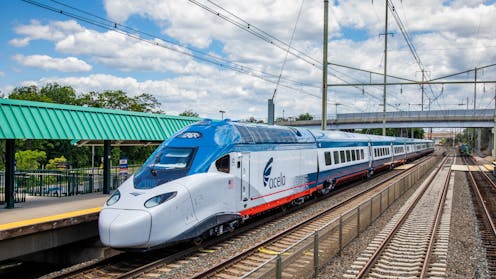 The new Acela trains are scheduled to start running on the Northeast Corridor soon. Courtesy of Amtrak
The new Acela trains are scheduled to start running on the Northeast Corridor soon. Courtesy of AmtrakWhen former President Joe Biden unveiled his US$1.9 trillion infrastructure plan in 2021, he found the perfect place to go public: Philadelphia’s 30th Street Station rail yard.
Over the din of crackling wires and grumbling engines, the president made his case for revitalizing the country’s roads, ports, airports and rail lines.
Behind Biden sat rows of gleaming Amtrak trains. Among them was a prototype of NextGen Acela, a sleek machine engineered to deliver the fastest passenger service in American history.
On Aug. 28, 2025, NextGen will finally hit the rails, after years of delays.
As the author of a book on the Northeast Corridor, the rail line that connects Boston, New York, Philadelphia and Washington, I know this new train cannot come soon enough for many seaboard riders, even though it launches at a time of diminished political will for passenger rail.
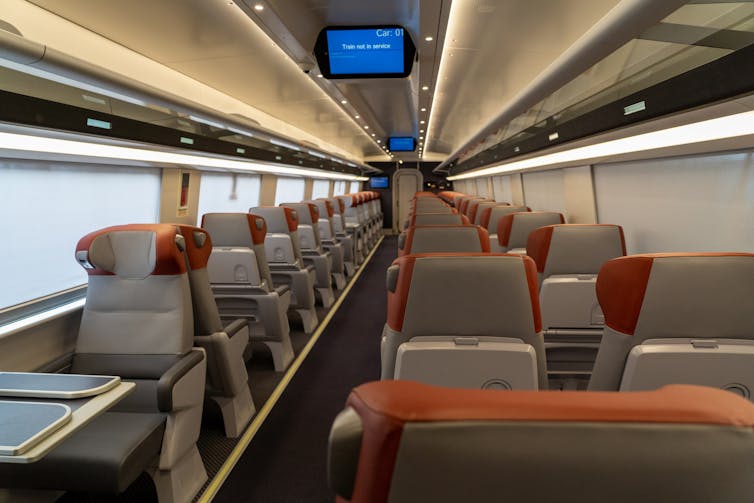 Red headrests distinguish first-class cars from business class on the NextGen Acela trains.Courtesy of Amtrak
Red headrests distinguish first-class cars from business class on the NextGen Acela trains.Courtesy of AmtrakRail renaissance under fire
The French-designed, American-manufactured NextGen arrives years late due to mechanical defects and failed simulation tests mandated by the Federal Railroad Administration. The new Acela will begin whisking passengers along the corridor after a chaotic year that saw downed wires, busted circuit breakers and brushfires disrupt Amtrak operations.
Gone is Amtrak’s White House champion, railfan-in-chief Biden, replaced by Donald Trump, whose one-time adviser, Elon Musk, called Amtrak a “sad situation,” and who proposed replacing the government-owned carrier with private competitors.
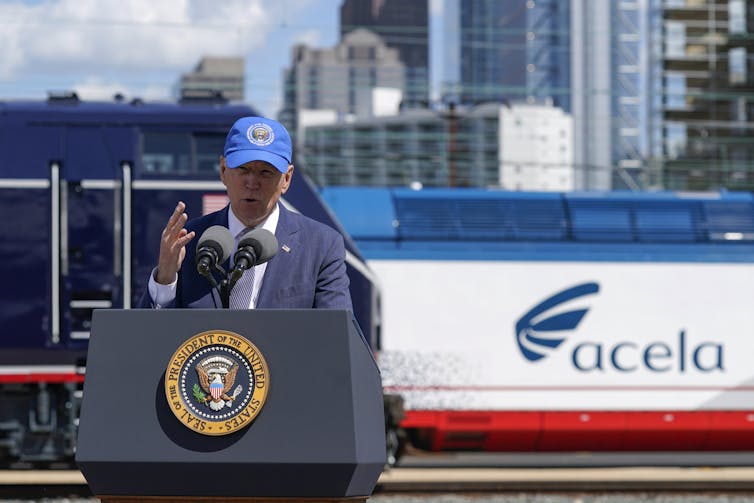 Former President Joe Biden delivers remarks at an Amtrak 50th anniversary event in Philadelphia in 2021.AP Photo/Patrick Semansky
Former President Joe Biden delivers remarks at an Amtrak 50th anniversary event in Philadelphia in 2021.AP Photo/Patrick SemanskyAmtrak CEO Stephen Gardner resigned in March 2025, and, in May, Amtrak cut 450 employee positions.
NextGen Acela promises an American rail renaissance in a moment when federally sponsored trains are fighting for their lives, as Biden’s infrastructure ambitions fall to an administration bent on cutting government costs.
These contradictions, however, are nothing new.
Not-so-fast trains
America’s love-hate relationship with fast trains stretches back to October 1964, when Japanese National Railways opened its Shinkansen high-speed line between Tokyo and Osaka.
Japan’s iconic 130-mph bullet train entranced audiences, many of whom saw footage of the new service during televised coverage of the Tokyo Olympics.
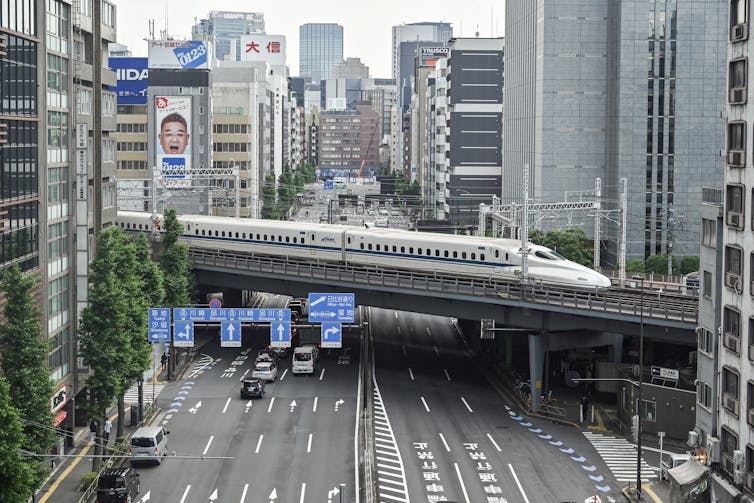 A Shinkansen high-speed bullet train passes through Tokyo.Richard A. Brooks/AFP via Getty Images
A Shinkansen high-speed bullet train passes through Tokyo.Richard A. Brooks/AFP via Getty ImagesAmericans wanted their own bullet train but were reluctant to pay the massive infrastructural costs of a Shinkansen system. When Congress passed the High-Speed Ground Transportation Act of 1965, it prioritized the development of trains over the reconstruction of tracks, power systems and maintenance facilities.
The resulting services underperformed.
On Dec. 20, 1967, a gas turbine train manufactured by United Aircraft topped 170 mph while testing in New Jersey. But when the so-called TurboTrain entered service, it managed an average pace of just 63 mph on the weaving track between New York and Boston.
The electric-powered Metroliner, which began service in 1969, boasted similar potential but rarely held triple-digit speeds in service and broke down so often that its carrier, the Penn Central Railroad, struggled to keep the trains running between New York and Washington.
Historians usually regard these high-speed forays as resounding failures.
But riders loved them.
Technical flaws aside, both the TurboTrain and Metroliner were a hit with northeastern riders, so much so that Amtrak retained the Metroliner brand until 2006, long after it had retired the ‘60s-era trains.
Reflecting in 1999, rail journalist Don Phillips expressed disbelief “that those dogs were actually popular with the riding public.”
The birth of Acela
Amtrak opened a new era of high-speed rail in 2000 when it launched Acela Express.
Derived from France’s acclaimed TGV design, Acela carries passengers at speeds up to 150 mph on the Northeast Corridor.
Like the Metroliner before it, Acela suffered from design problems and mechanical faults, including cracked yaw dampers and brake discs, which temporarily sidelined the trains.
Rail writer Joseph Vranich described Acela as both “Amtrak’s crown jewel” and a “remarkable fiasco.”
And yet riders flocked to the service. Acela became one of Amtrak’s most popular and lucrative trains – so attractive that it lured business travelers off regional airlines.
When Acela entered service in 2000, Amtrak trains claimed just 37% of air-rail traffic between New York and Washington. By 2021, it had 83%. Between New York and Boston, that figure jumped from 20% to 75%.
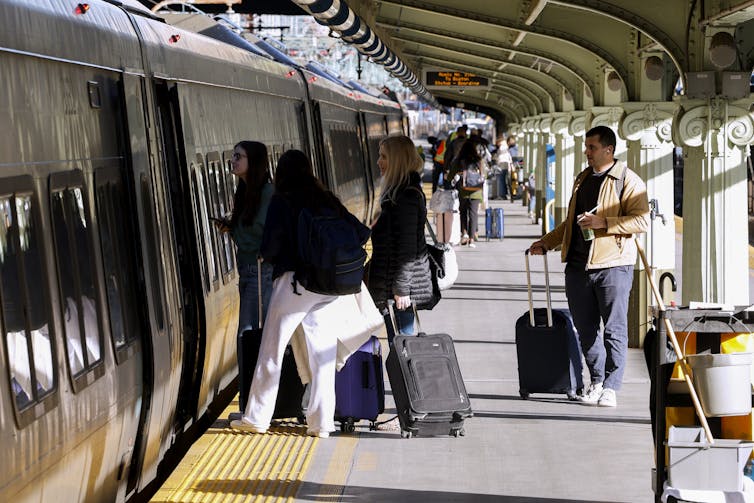 Acela trains are popular and lucrative for Amtrak, in part because they draw so many business travelers.Anna Moneymaker via Getty Images
Acela trains are popular and lucrative for Amtrak, in part because they draw so many business travelers.Anna Moneymaker via Getty ImagesAcela 2.0
Now, NextGen Acela takes up the fraught legacy of American high-speed rail. What can we expect of the new train?
NextGen is faster than the original Acela but will not set any world speed records. Its top velocity of 160 mph falls short of global benchmarks set by China’s Fuxing, which hits 217 mph, and Japan’s newest Shinkansens, which reach 200 mph.
With better tracks and signals, NextGen could conceivably ramp up to 186 mph, though such speeds won’t be possible anytime soon.
For now, NextGen will make do with an imperfect corridor. The train’s lightweight design means faster acceleration and lower energy consumption. An enhanced dynamic tilting system will let carriages lean into curves on the corridor’s twisting track, so they lose less speed on turns. The original Acela also tilted, but not as much.
 The NextGen Acela bathrooms are more spacious and have more touchless features than the previous design.Courtesy of Amtrak
The NextGen Acela bathrooms are more spacious and have more touchless features than the previous design.Courtesy of AmtrakThe upgraded onboard experience includes winged headrests, seat-side USB ports and 5G Wi-Fi. More importantly, each NextGen train can seat 82 more passengers than its predecessor. When Amtrak’s full fleet of 28 NextGens enters service, sending the first-generation trains into retirement, Acela service capacity will have increased by 4,728 seats.
This figure may be the train’s greatest achievement in a congested region at a time when Amtrak is posting record ridership.
The effects of the Northeast’s post-pandemic passenger surge are nowhere more visible than the Philadelphia rail yard where Biden spoke four years ago. Amtrak is constructing a new maintenance shop beside the Schuylkill River that will service NextGen trains and cement Philly’s role in the railroad’s addition of a million annual seats to its non-Acela corridor trains. Powered by conventional electric locomotives, these slower, cheaper “Regionals” accounted for 77% of corridor ridership in 2024 and will continue to carry the bulk of northeastern passengers.
Meanwhile, a quarter-mile south of the maintenance shop, America’s third-busiest passenger hub, 30th Street Station, is receiving a generational overhaul with a new food court, exterior plaza, shops and underground access to rapid transit.
These projects demonstrate the economic power of fast, frequent trains in Philly and throughout trackside communities of the Northeast. America’s embattled but resilient high-speed rail tradition may never be the world’s best, but even incremental improvements, like NextGen, cannot help but transform the places they serve.
For Amtrak’s corridor region, the stakes have never been higher.
Read more of our stories about Philadelphia.
David Alff is a member of the Empire State Passenger Association.
Authors: David Alff, Associate Professor of English, University at Buffalo

